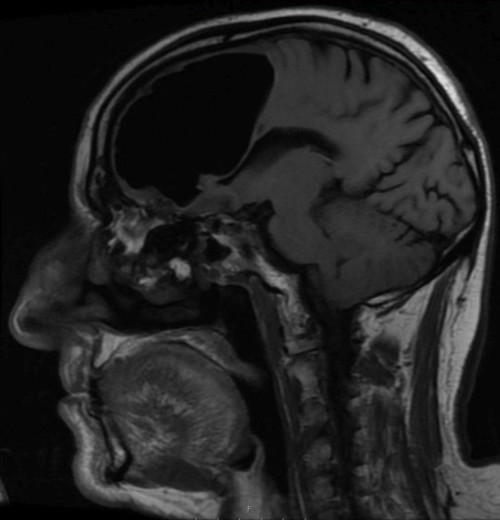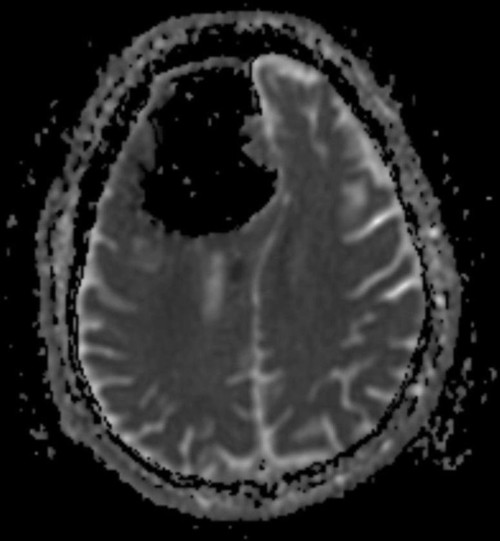In the brain of an elderly man found a large cavity with air

The striking vitality of the brain, the ability to redistribute functions and reconfigure neural connections between different departments is still an inexplicable phenomenon. Some clinical cases are really amazing. One of the most famous cases is the story of a 55-year-old French man who has lived a relatively normal and healthy life for more than ten years , despite the absence of 90% of the brain . The scientific article was first published by the journal Lancet in 2007. It gave rise to a serious discussion and even a revision of the theories about the biological essence of consciousness .
That story was not the only one. February 27, 2018 in the journal BMJ Case Reports described another phenomenal case .
An 84-year-old man was admitted to the Emergency Department of Causeway Hospital in Coleraine (Northern Ireland) in the direction of a therapist who complained of repeated falls, loss of balance, and a sense of instability for several months. He also said that for the last three days he has felt weakness in his left arm and left leg. At the same time, the patient was not observed violations in vision, speech and facial expressions. In all other respects, he felt good, lived a normal life with his wife and two sons, showed physical activity, without needing outside help.
The patient did not smoke tobacco and seldom consumed alcohol. In his medical history, too, did not find something special. Studies of the functions of the central nervous system and PNS revealed no abnormalities, as well as a blood test.
')
The state of loss of balance and involuntary falls in the elderly is not uncommon. When it is accompanied by weakness in one half of the body, a CT scan of the brain is often prescribed. Causes of attacks may have a different etiology. At this age, diseases of atherosclerotic and embolic origin are most common. But there are exceptions. In this case, it turned out to be just such a rare case.
CT scan of the brain immediately showed an anomaly, visible to the naked eye. She was later confirmed on an MRI.

You can imagine the amazement of the provincial doctors from the Irish backwoods: “We were all very puzzled by the images received,” recalls Dr. Finlay Brown, who worked at the Causeway Emergency Department at the time of the Causeway Hospital and was the first to see the images of CT. The results of the scan were so unusual that the doctors doubted the patient's testimony and began to remind him that he probably forgot about the surgery he had performed on the brain or a congenital defect. He said he did not forget, and there was nothing like that.
A large (9 cm long) air-filled cavity is clearly visible in the right frontal lobe. The air bubble in the brain called a pneumatocoele is under pressure - they always (in 100% of cases) remain after surgery, only much smaller.

The doctors decided that most likely the cavity was formed as a result of the development of a large osteoma - a benign bone tumor in the ethnoid cells, that is, in the sinus sinuses near the nose. The osteoma is clearly visible in the MRI image. Because of this, a "one-sided" air channel was formed, through which the air passed into the brain, but could not go back. Doctors say that this air cavity increased in months or years - for example, every time a man inhaled / coughed / sneezed, a small portion of air could enter the brain through diseased tissue.
After consulting with neurosurgeons, the doctors offered the patient an operation that includes a frontal craniotomy, removal of air under pressure with subsequent procedures, as well as removal of the osteoma, which the ENT should have performed separately. The patient made an informed decision not to carry out the operations, taking into account risks and benefits.
As a result, the patient with a cavity in the brain stayed in the hospital for some time because he had a cold (an infection of the lower respiratory tract), and then went home. He was prescribed secondary prevention of stroke and was advised to go to the hospital if his symptoms worsen. It is also noted that the weakness in the left arm and leg after 12 weeks passed by itself and the man felt good.
An article describing this medical case was published on February 27, 2018 in the journal BMJ Case Reports (doi: 10.1136 / bcr-2017-222892).
Source: https://habr.com/ru/post/410831/
All Articles